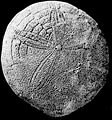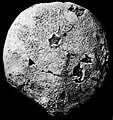The Echinoid Directory
Neocatopygus Duncan & Sladen, 1882, p. 76
| Diagnostic Features |
|
|---|---|
| Distribution |
|
| Name gender | masculine |
| Type | Neocatopygus rotundus Duncan & Sladen, 1882, p. 76; by monotypy. |
| Species Included |
|
| Classification and/or Status | Irregularia; Cassiduloida; 'Gitolampadids'. |
| Remarks |
|





